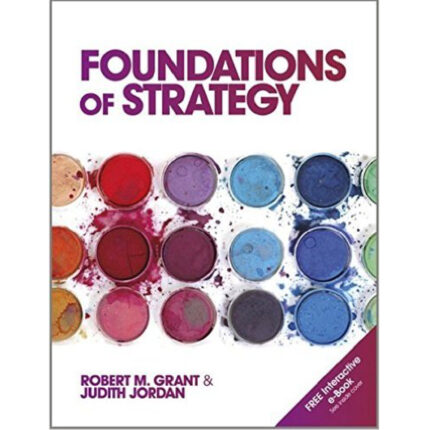Overview
True / False
Chapter 11
Strategic Leadership: Creating a Learning Organization and an Ethical Organization
1) Three key interdependent strategic leadership activities are: designing the organization, determining its direction, and nurturing a culture dedicated to excellence and ethical behavior.
Answer: TRUE
Explanation: Many authors contend that successful leaders must recognize three interdependent activities that must be continually reassessed for organizations to succeed. These are: (1) setting a direction, (2) designing the organization, and (3) nurturing a culture dedicated to excellence and ethical behavior.
Difficulty: 2 Medium
Topic: Value of Strategic Leadership
Learning Objective: 11-01 The three key interdependent activities in which all successful leaders must be continually engaged.
Bloom’s: Understand
AACSB: Knowledge Application
Accessibility: Keyboard Navigation
2) Setting a direction is the leadership activity that involves developing a strategic vision of what the organization could become.
Answer: TRUE
Explanation: A holistic understanding of the organization stakeholders requires an ability to scan the environment to develop knowledge of all of the company stakeholders and other salient environmental trends and events. Managers must integrate this knowledge into a vision of what the organization could become.
Difficulty: 2 Medium
Topic: Value of Strategic Leadership
Learning Objective: 11-01 The three key interdependent activities in which all successful leaders must be continually engaged.
Bloom’s: Understand
AACSB: Knowledge Application
Accessibility: Keyboard Navigation
3) The tendency of many individuals to invest further in decisions providing positive performance feedback is referred to as escalation.
Answer: FALSE
Explanation: Many people have vested interests in the status quo. People tend to be risk averse and resistant to change. There is a broad stream of research on escalation, wherein certain individuals continue to throw good money at bad decisions despite negative performance feedback.
Difficulty: 2 Medium
Topic: Value of Strategic Leadership
Learning Objective: 11-02 Two elements of effective leadership: overcoming barriers to change and using power effectively.
Bloom’s: Analyze
AACSB: Knowledge Application
Accessibility: Keyboard Navigation
4) Behavioral barriers to change occur because of conflicts between departments, conflicts arising from power relationships, and refusal to share information.
Answer: FALSE
Explanation: Behavioral barriers cause managers to look at issues from a biased or limited perspective due to their education, training, work experiences, and so forth. Political barriers refer to conflicts arising from power relationships.
Difficulty: 2 Medium
Topic: Value of Strategic Leadership
Learning Objective: 11-02 Two elements of effective leadership: overcoming barriers to change and using power effectively.
Bloom’s: Analyze
AACSB: Analytical Thinking
Accessibility: Keyboard Navigation
5) Leaders must draw on a range of personal skills as well as organizational mechanisms to move their organizations forward in the face of barriers to change.
Answer: TRUE
Explanation: Leaders must draw on a range of personal skills as well as organizational mechanisms to move their organizations forward in the face of such barriers to change. One of the most important tools a leader has for overcoming barriers to change is their personal and organizational power.
Difficulty: 2 Medium
Topic: Value of Strategic Leadership
Learning Objective: 11-02 Two elements of effective leadership: overcoming barriers to change and using power effectively.
Bloom’s: Analyze
AACSB: Analytical Thinking
Accessibility: Keyboard Navigation
6) Emotional intelligence (EI) is one of the components of a high intelligence quotient (IQ).
Answer: FALSE
Explanation: The five components of EI are: self-awareness, self-regulation, motivation, empathy, and social skill. Findings indicate that EI is a better predictor of life success (economic well-being, satisfaction with life, friendship, family life), including occupational attainments, than IQ.
Difficulty: 2 Medium
Topic: Value of Strategic Leadership
Learning Objective: 11-03 The crucial role of emotional intelligence (EI) in successful leadership, as well as its potential drawbacks.
Bloom’s: Analyze
AACSB: Knowledge Application
Accessibility: Keyboard Navigation
7) Empathy, one of the components of emotional intelligence (EI), refers to personal proficiency in managing relationships and building networks.
Answer: FALSE
Explanation: Empathy means thoughtfully considering employee feelings, along with other factors, in the process of making intelligent decisions. Empathy is particularly important in the business environment today for at least three reasons: the increasing use of teams, the rapid pace of globalization, and the growing need to retain talent.
Difficulty: 2 Medium
Topic: Value of Strategic Leadership
Learning Objective: 11-03 The crucial role of emotional intelligence (EI) in successful leadership, as well as its potential drawbacks.
Bloom’s: Analyze
AACSB: Knowledge Application
Accessibility: Keyboard Navigation
8) People with strong self-awareness are overly critical and unrealistically optimistic and are well suited to run organizations because they will make good judgment calls.
Answer: FALSE
Explanation: Self-awareness involves a person having a deep understanding of his or her emotions, strengths, weaknesses, and drives. People with strong self-awareness are neither overly critical nor unrealistically optimistic. Instead, they are honest with themselves and others. People who assess themselves honestly (i.e., self-aware people) are well suited to do the same for the organizations they run.
Difficulty: 2 Medium
Topic: Value of Strategic Leadership
Learning Objective: 11-03 The crucial role of emotional intelligence (EI) in successful leadership, as well as its potential drawbacks.
Bloom’s: Analyze
AACSB: Analytical Thinking
Accessibility: Keyboard Navigation
9) A key function of the leaders in a learning organization is to generate an organization-wide commitment to the status quo.
Answer: FALSE
Explanation: A learning environment involves organization-wide commitment to change, an action orientation, and applicable tools and methods. It must be viewed by everyone as a guiding philosophy and not simply as another change program.
Difficulty: 2 Medium
Topic: Value of Strategic Leadership
Learning Objective: 11-04 The importance of creating a learning organization.
Bloom’s: Analyze
AACSB: Analytical Thinking
Accessibility: Keyboard Navigation
10) Inspiring and motivating people with a mission or purpose is a necessary and sufficient condition for developing a learning organization.
Answer: FALSE
Explanation: Inspiring and motivating people with a mission or purpose is a necessary, but not sufficient, condition for developing an organization that can learn and adapt to a rapidly changing, complex, and interconnected environment.
Difficulty: 2 Medium
Topic: Value of Strategic Leadership
Learning Objective: 11-04 The importance of creating a learning organization.
Bloom’s: Analyze
AACSB: Analytical Thinking
Accessibility: Keyboard Navigation













Reviews
There are no reviews yet.